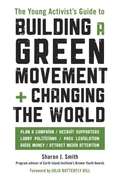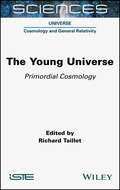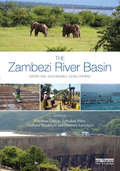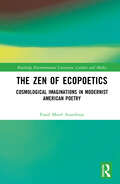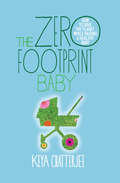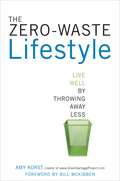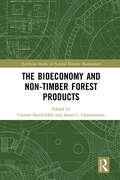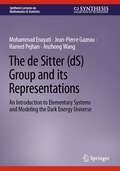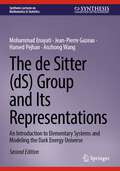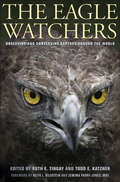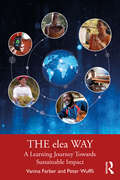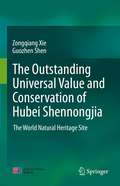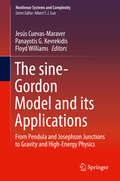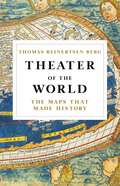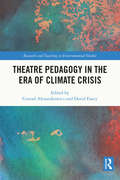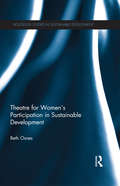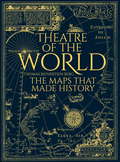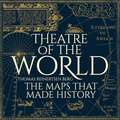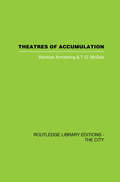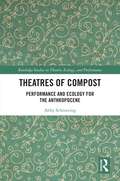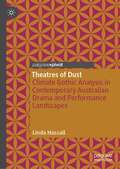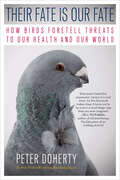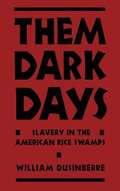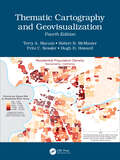- Table View
- List View
The Young Activist's Guide to Building a Green Movement + Changing the World
by Sharon J. SmithIf you want to make a significant and sustainable impact on the health of our planet, this powerful and practical guide can help. Author and activist Sharon J. Smith shares proven strategies and lessons learned from the winners of Earth Island Institute#x19;s Brower Youth Awards-America#x19;s top honor for young green leaders. Here are all the tools you need-from planning a campaign and recruiting supporters to raising money and attracting media attention-to turn your ideas into actions and make changes that matter. All author proceeds from the sale of this book go to Earth Island Institute#x19;s Brower Youth Awards to support the next generation of young activists.
The Young Universe: Primordial Cosmology
by Richard TailletThe Young Universe presents four major physical and astrophysical themes related to these extreme phases of the primordial universe. In particular, it presents the physics of the primordial plasma and the concepts of quantum and particle physics necessary to describe this extreme state.It discusses the cosmological background radiation and explores inflation, an extremely rapid expansion phase that is believed to have occurred very early in cosmological history and to have shaped our present universe. The book also provides a synthesis of the dark matter problem.
The Zambezi River Basin: Water and sustainable development (Earthscan Series on Major River Basins of the World)
by Jonathan Lautze, Zebediah Phiri, Vladimir Smakhtin and Davison SarucheraThe Zambezi river is the fourth longest in Africa, crossing or bordering Zambia, Angola, Namibia, Botswana, Zimbabwe and Mozambique. The river basin is widely recognised as one of the most important basins in southern Africa and is the focus of contested development, including water for hydropower and for agriculture and the environment. This book provides a thorough review of water and sustainable development in the Zambezi, in order to identify critical issues and propose constructive ways forward. The book first reviews the availability and use of water resources in the basin, outlines the basin’s economic potential and highlights key concerns related to climate vulnerability and risk. Focus is then devoted to hydropower and the water-energy-food (WEF) nexus, sustainable agricultural water management, and threats and opportunities related to provision of ecosystem services. The impact of urbanisation and water quality is also examined, as well as ways to enhance transboundary water cooperation. Last, the book assesses the level of water security in the basin, and provides suggestions for achieving Sustainable Development Goal (SDG) 6. Throughout, emphasis is placed on entry points for basin-level management to foster improved paths forward.
The Zen of Ecopoetics: Cosmological Imaginations in Modernist American Poetry (Routledge Environmental Literature, Culture and Media)
by Enaiê Mairê AzambujaThis book is the first comprehensive study investigating the cultural affinities and resonances of Zen in early twentieth-century American poetry and its contribution to current definitions of ecopoetics, focusing on four key poets: William Carlos Williams, Marianne Moore, Wallace Stevens, and E.E. Cummings. Bringing together a range of texts and perspectives and using an interdisciplinary approach that draws on Eastern and Western philosophies, including Zen and Taoism, posthumanism and new materialism, this book adds to and extends the field of ecocriticism into new debates. Its broad approach, informed by literary studies, ecocriticism, and religious studies, proposes the expansion of ecopoetics to include the relationship between poetic materiality and spirituality. It develops ‘cosmopoetics’ as a new literary-theoretical concept of the poetic imagination as a contemplative means to achieving a deeper understanding of the human interdependence with the non-human. Addressing the critical gap between materialism and spirituality in modernist American poetry, The Zen of Ecopoetics promotes new forms of awareness and understanding about our relationship with non-human beings and environments. It will be of interest to scholars, researchers, and students in ecocriticism, literary theory, poetry, and religious studies.
The Zero Footprint Baby
by Keya ChatterjeeIn our culture, pregnancy, birth, and childrearing are deeply connected to consumption and resource use. From the baby shower to the minivan and the larger apartment or first house, the baby-raising years are the most hyper-consumptive of our lives, and can set a family on an unsustainable track for years to come. The Zero Footprint Baby: How to Save the Planet While Raising a Healthy Baby shows how to raise a child with little to no carbon footprint. The book covers every issue new parents face, including pregnancy (what kind of birth has the lowest impact); what to feed your baby (breastfeed, formula, or both?), childcare (who should take care of the baby, and how?), and of course, diapering. Using a mix of personal anecdotes, summarized research, and clear guidance on how to pursue the most sustainable baby-rearing options, The Zero Footprint Baby is the resource and reference book for all new parents with green inclinations. Keya Chatterjee is the director for international climate policy at the World Wildlife Fund. She previously served as a climate change specialist at the US Agency for International Development, and also worked on communicating climate issues while at NASA. Keya's commentary on climate change policy and sustainability issues has been quoted in numerous media outlets, including USA Today, The New York Times, Fox News, The Associated Press, The Washington Post, and NBC Nightly News. She was also featured in a special issue of Politico on climate change highlighting the "muscle of the movement."
The Zero-Waste Lifestyle: Live Well by Throwing Away Less
by Amy KorstA practical guide to generating less waste, featuring meaningful and achievable strategies from the blogger behind The Green Garbage Project, a yearlong experiment in living garbage-free.Trash is a big, dirty problem. The average American tosses out nearly 2,000 pounds of garbage every year that piles up in landfills and threatens our air and water quality. You do your part to reduce, reuse, and recycle, but is it enough? In The Zero-Waste Lifestyle, Amy Korst shows you how to lead a healthier, happier, and more sustainable life by generating less garbage. Drawing from lessons she learned during a yearlong experiment in zero-waste living, Amy outlines hundreds of easy ideas--from the simple to the radical--for consuming and throwing away less, with low-impact tips on the best ways to: * Buy eggs from a local farm instead of the grocery store * Start a worm bin for composting * Grow your own loofah sponges and mix up eco-friendly cleaning solutions * Purchase gently used items and donate them when you're finished * Shop the bulk aisle and keep reusable bags in your purse or car * Bring your own containers for take-out or restaurant leftovers By eliminating unnecessary items in every aspect of your life, these meaningful and achievable strategies will help you save time and money, support local businesses, decrease litter, reduce your toxic exposure, eat well, become more self-sufficient, and preserve the planet for future generations.
The bioeconomy and non-timber forest products (Earthscan Studies in Natural Resource Management)
by Carsten Smith-Hall James L. ChamberlainThis book provides the first in-depth investigation of how non-timber forest products are an integral part of local, national, and global bioeconomies. While the plants and fungi that produce non-timber forest products are essential to the sustainability of forest ecosystems, peoples' food and livelihood security and sovereignty, and thus the bioeconomy, are often absent from bioeconomic strategies. Presenting a selection of empirical cases from around the world that engage with the bioeconomy and non-timber forest products, this volume reveals how essential these products are to creating a greener and more sustainable future, how to to better integrate them into efforts to transition to and expand the bioeconomy, and how such efforts can be supported and developed. Chapters analyse how and to what degree non-timber forest products promote sustainable resource use, generate employment, and contribute to food and livelihood security and poverty alleviation. The volume develops approaches and identifies interventions and policies to support the integration of non-timber forest products into bioeconomy strategies, including in national reporting schemes to provide recommendations for future research and practical implementation. This book will be of great interest to students and scholars of forest and natural resource management, bioeconomics, circular economy and ecological economics more widely. It will also be of interest to professionals working in sustainable development and the forestry sector.
The de Sitter: An Introduction to Elementary Systems and Modeling the Dark Energy Universe (Synthesis Lectures on Mathematics & Statistics)
by Jean-Pierre Gazeau Mohammad Enayati Hamed Pejhan Anzhong WangThis book reviews the construction of elementary systems living in de Sitter (dS) spacetime, in both the classical and quantum senses. Field theories on dS spacetime are among the most studied mathematical models of the Universe, whether for its earlier period (inflationary phase) or for its current phase of expansion acceleration (dark energy or cosmological constant). Classical elementary systems are Hamiltonian phase spaces, which are associated with co-adjoint orbits of the relativity group. On the other hand, quantum elementary systems are associated with (projective) unitary irreducible representations of the (possibly extended) relativity group (or one of its covering). This study emphasizes the conceptual issues arising in the formulation of such systems and discusses known results in a mathematically rigorous way. Particular attention is paid to: “smooth” transition from classical to quantum theory; physical content under vanishing curvature, from the point of view of a local (“tangent”) Minkowskian observer; and thermal interpretation (on the quantum level), in the sense of the Gibbons-Hawking temperature. Such a mathematical construction is of paramount importance to the understanding of the early Universe (due to the critical role that the dS metric plays in the inflationary cosmological scenarii) as well as to the construction of possible models for late-time cosmology (since a small positive cosmological constant or dark energy seems to be required by recent data). In this sense, this book uniquely blends mathematical physics (spacetime symmetry on classical and quantum levels) and theoretical physics (quantization, quantum field theory, and cosmology). Moreover, the level of exposition varies in different parts of the book so that both experts and beginners alike can utilize the book.
The de Sitter: An Introduction to Elementary Systems and Modeling the Dark Energy Universe (Synthesis Lectures on Mathematics & Statistics)
by Jean-Pierre Gazeau Mohammad Enayati Hamed Pejhan Anzhong WangThis Second Edition is a comprehensive update, integrating the latest research and theoretical advancements in the field of de Sitter (dS) group representations. Building on the success of the first edition, the book offers a more in-depth analysis of mathematical aspects, conceptual foundations, and practical implications related to the dS group, including its Lie manifold, Lie algebra, and co-adjoint orbits, viewing the latter as potential classical elementary systems within the context of dS spacetime. Additionally, the examination of unitary irreducible representations (UIRs) sheds light on the potential existence of quantum elementary systems within the dS spacetime framework. The authors emphasize consistency with Wigner's approach to elementary systems, incorporate Wigner's principles and exploring projective UIRs of the dS group, and provide a deeper insight into the nature of dS elementary systems. Particular attention is paid to: the “smooth” transition from classical to quantum theory, the physical content under vanishing curvature, and the thermal interpretation from a quantum perspective. The book also focuses on the physical interpretation of elementary systems in curved spacetimes, recognizing the limitations of traditional concepts derived from flat Minkowski spacetime and the Poincaré group.
The eBook Insider
by Random HouseThe eBook Insider is the ultimate readers' resource for choosing great books. The perfect first stop to make along the way as you fill your e-reader with the books that you'll want to have in your library and recommend to friends. It's the place to find out what some of your favorite authors are reading and recommending, including Dan Brown, Nora Ephron, Carl Hiaasen, Alexander McCall Smith, Chuck Palahniuk, and others. All in one place you can preview excerpts from the best books of the year, from winners of the National Book Award, the Man Booker Prize and the Pulitzer Prize to New York Times Notable Book selections. Whether you love fiction, history, biographies or are looking for a thriller to keep you up all night, a thought-provoking pick for your reading group, or the latest book to be adapted into a movie, you're bound to find just what you're looking for when you consult The eBook Insider. All of this from the editors and authors you'll want to turn to for the best recommendations in reading, both on the printed page and on your e-reading device.
The eagle watchers: observing and conserving raptors around the world
by Jemima Parry-Jones Ruth E. Tingay Todd E. Katzner Keith L. BildsteinEagles have fascinated humans for millennia. For some, the glimpse of a distant eagle instantly becomes a treasured lifelong memory. Others may never encounter a wild eagle in their lifetime. This book was written by people who have dedicated years to the study of eagles, to provide an insider's view for all readers, but especially those who have never been up close and personal with these magnificent yet often misunderstood creatures.In their stories, twenty-nine leading eagle researchers share their remarkable field experiences, providing personal narratives that don't feature in their scientific publications. They tell of their fear at being stalked by grizzly bears, their surprise at being followed by the secret police, their embarrassment when accidentally firing mortar rockets over a school gymnasium, and their sense of awe at tracking eagles via satellite. The reader experiences the cultural shock of being guest of honor at a circumcision ceremony, the absurdity of sharing an aquatic car with the Khmer Rouge, and the sense of foreboding at being press-ganged into a frenzied tribal death march through the jungle. The Eagle Watchers covers twenty-four species on six continents, from well known (bald eagle; golden eagle), to obscure (black-and-chestnut eagle; New Guinea harpy eagle), and from common (African fish eagle) to critically endangered (Philippine eagle; Madagascar fish eagle). The diverse experiences vividly described in this book reveal the passion, dedication, and sense of adventure shared by those who study these majestic birds and strive for their conservation. Featuring stunning color photographs of the eagles, information on raptor conservation, a global list of all eagle species with ranges and conservation status, and a color map of the sites visited in the book, The Eagle Watchers will appeal to birders, conservationists, and adventure travelers alike. To further support the conservation programs described in this book, all royalties are being donated to two leading nonprofit organizations for raptor conservation training and fieldwork: Hawk Mountain Sanctuary Intern Program and the National Birds of Prey Trust.
The elea Way: A Learning Journey Toward Sustainable Impact
by Vanina Farber Peter WuffliSocial entrepreneurship and impact investing contribute to a more inclusive capitalism and bring innovative solutions to global challenges, such as fighting poverty and protecting planet earth. This book offers practical advice on how to best integrate entrepreneurship and capital for impact and innovation by using elea’s philanthropic investing approach to fight absolute poverty with entrepreneurial means as an example. Written by two leading experts, the book summarizes insights from elea’s 15-year pioneering journey, from creating an investment organization, choosing purposeful themes, and sourcing opportunities, to partnering with entrepreneurs for impact creation. This includes suggestions on how to lead impact enterprises in such areas as developing strategies, plans, and models; building effective teams and organizations; managing resources; and handling crises. Using real-life examples, this is valuable reading for entrepreneurs, investors, executives, philanthropists, policymakers, and anyone curious about entrepreneurship and inclusive capitalism.
The outstanding universal value and conservation of Hubei Shennongjia: The World Natural Heritage Site
by Guozhen Shen Zongqiang XieThis book owes a great deal to the outstanding universal value of the natural heritage of Hubei Shennongjia, which offers an outstanding example of the ongoing ecological processes occurring in the development of intact subtropical mixed broad-leaved evergreen and deciduous forests in the northern hemisphere. The book demonstrates the value from the typical example of mountain altitudinal biological zones in the Oriental Deciduous Forest Biogeographical Province, and the vital origin location for global temperate flora, harboring the highest concentration of global temperate genera. Moreover, the heritage value in exceptional biodiversity and key habitat for numerous relic, rare, endangered, endemic, and type specimen species are presented. The richness of deciduous woody species in Shennongjia is the highest in the world.
The sine-Gordon Model and its Applications
by Jesús Cuevas-Maraver Panayotis G. Kevrekidis Floyd WilliamsThe sine-Gordon model is a ubiquitous model of Mathematical Physics with a wide range of applications extending from coupled torsion pendula and Josephson junction arrays to gravitational and high-energy physics models. The purpose of this book is to present a summary of recent developments in this field, incorporating both introductory background material, but also with a strong view towards modern applications, recent experiments, developments regarding the existence, stability, dynamics and asymptotics of nonlinear waves that arise in the model. This book is of particular interest to a wide range of researchers in this field, but serves as an introductory text for young researchers and students interested in the topic. The book consists of well-selected thematic chapters on diverse mathematical and physical aspects of the equation carefully chosen and assigned.
Theater of the World: The Maps that Made History
by Thomas Reinertsen BergA beautifully illustrated full-color history of mapmaking across centuries-- a must-read for history buffs and armchair travelers. Theater of the World offers a fascinating history of mapmaking, using the visual representation of the world through time to tell a new story about world history and the men who made it. Thomas Reinertsen Berg takes us all the way from the mysterious symbols of the Stone Age to Google Earth, exploring how the ability to envision what the world looked like developed hand in hand with worldwide exploration. Along the way, we meet visionary geographers and heroic explorers along with other unknown heroes of the map-making world, both ancient and modern. And the stunning visual material allows us to witness the extraordinary breadth of this history with our own eye
Theatre Pedagogy in the Era of Climate Crisis (Research and Teaching in Environmental Studies)
by David Fancy Conrad AlexandrowiczThis volume explores whether theatre pedagogy can and should be transformed in response to the global climate crisis. Conrad Alexandrowicz and David Fancy present an innovative re-imagining of the ways in which the art of theatre, and the pedagogical apparatus that feeds and supports it, might contribute to global efforts in climate protest and action. Comprised of contributions from a broad range of scholars and practitioners, the volume explores whether an adherence to aesthetic values can be preserved when art is instrumentalized as protest and considers theatre as a tool to be employed by the School Strike for Climate movement. Considering perspectives from areas including performance, directing, production, design, theory and history, this book will prompt vital discussions which could transform curricular design and implementation in the light of the climate crisis. Theatre Pedagogy in the Era of Climate Crisis will be of great interest to students, scholars and practitioners of climate change and theatre and performance studies.
Theatre for Women's Participation in Sustainable Development (Routledge Studies in Sustainable Development)
by Beth OsnesThough development researchers have proven that the participation of women is necessary for effective sustainable development, development practitioners still largely lack culturally appropriate, gender-sensitive tools for including women, especially women living in poverty. Current tools used in the development approach often favour the skill set of the development practitioner and are a mismatch with the traditional, gendered knowledge and skills many women who are living in poverty do have. This study explores three case studies from India, Ethiopia, and the Guatemala that have successfully used applied theatre for women’s participation in sustainable development. This interdisciplinary book has the opportunity to be the first to bring together the theory, scholarship and practice of theatre for women’s participation in sustainable development in an international context. This work will be of great interest to scholars and practitioners in a wide variety of fields who are looking for creative solutions for utilizing the contributions of women for solving our global goals to live in a sustainable way on this one planet in a just and equitable manner.
Theatre of the World: The History of Maps and the Men and Women Who Made Them
by Thomas Reinertsen Berg'Fascinating...sumptuously produced with lots of full-colour images, is a kind of potted treasury of cartographical history that gleams with pieces-of-eight-like snippets of information...this is an enthralling book, and joins the likes of Simon Garfield's On the Map and Jerry Brotton's A History of the World in Twelve Maps in the field of popular reaffirmations of the ingenuity of geography.' Travis Elborough, Spectator'A fascinating book that I will always treasure.' Sir Ranulph Fiennes 'This wonderful book is a reminder of how much careful thought was given to the shape of the world even in ancient times - the landscape, how places are related to one another. I pored over these maps for hours, imagining those minds hard at work, visualising how it all connected as a whole. Just brilliant.' Neil Oliver'Visually stunning...it's gone straight to the top of my Christmas present list.' The Bookseller'I remember how well I liked to turn the pages of my childhood atlas and travel the world to find out where countries and cities were. But there was never anything about why the maps were created - or who drew them. Theatre of the World was my big chance to tell the stories of all those men and women map makers whose amazing work deserves to be celebrated.' Thomas Reinertsen BergBeautifully illustrated and rich in detail, Theatre of the World reignites our curiosity with the world both ancient and modern. Before you could just put finger to phone to scroll Google Maps, in advance of the era of digital mapping and globes, maps were being constructed from the ideas and questions of pioneering individuals.From visionary geographers to heroic explorers, from the mysterious symbols of the Stone Age to the familiar navigation of Google Earth, Thomas Reinertsen Berg examines the fascinating concepts of science and worldview, of art and technology, power and ambitions, practical needs and distant dreams of the unknown.
Theatre of the World: The History of Maps and the Men and Women Who Made Them
by Thomas Reinertsen Berg'Visually stunning...it's gone straight to the top of my Christmas present list.' The Bookseller'I remember how well I liked to turn the pages of my childhood atlas and travel the world to find out where countries and cities were. But there was never anything about why the maps were created - or who drew them. Theatre of the World was my big chance to tell the stories of all those men and women map makers whose amazing work deserves to be celebrated.' Thomas Reinertsen BergBeautifully written and rich in detail, Theatre of the World reignites our curiosity with the world both ancient and modern. Before you could just put finger to phone to scroll Google Maps, in advance of the era of digital mapping and globes, maps were being constructed from the ideas and questions of pioneering individuals.From visionary geographers to heroic explorers, from the mysterious symbols of the Stone Age to the familiar navigation of Google Earth, Thomas Reinertsen Berg examines the fascinating concepts of science and worldview, of art and technology, power and ambitions, practical needs and distant dreams of the unknown.(P)2018 Hodder & Stoughton Limited
Theatres of Accumulation: Studies in Asian and Latin American Urbanization
by Warwick Armstrong T.G. McGeeIn the great cities of Latin America and Asia, international business and local firms meet and, in particular, influence teh development strategies of Third World countries. The authors of Theatres of Accumulation argue that these cities play a crucial role in the process of capital accumulation and of unequal exchange and dependency. They examine the twin patterns of convergence and divergence in lifestyles and economic activities, and show how the flow of capital through the urban system beings net losses to the rural regions and further exacerbates income inequalities between regions and classes. Theatres of accumulation provides an overview of urbanization in the Third World, as well as specific case studies. It deals with theoretical issues and projects the likely developments in urbanization in the future. Armstrong and McGee's work is essential reading for social science and planning professionals and students, in the developed world and the Third World, who are concerned with urban processes. This book was first published in 1985.
Theatres of Compost: Performance and Ecology for the Anthropocene (Routledge Studies in Theatre, Ecology, and Performance)
by Abby SchroeringTheatres of Compost places ecology at the center of performance scholarship and criticism, and it positions performance as a key cultural process for bringing about a more just and sustainable future.Examining a unique archive of agricultural performances—plays, theatre collectives, and activist rituals that engage questions of how humans use the land and produce food—this book lays out a framework for how theatre and performance contribute to a cultural shift toward ecological awareness. Theatre of compost is performance that directly engages ideologies of exploitation, mass production, and accumulation. Instead of discarding the forms, themes, methodologies, and histories that have perpetuated ecological destruction, the case studies in this book show that what has come before can be composted: broken down and reconstituted as the fertile foundation for a more livable life in the Anthropocene. Theatres of Compost will appeal to the new but quickly growing subfield of performance and ecology. As the climate and ecological crises worsen, more scholars and students in theatre and performance will be searching for ways to make their work meaningful and relevant.This book will be a helpful resource for graduate-level courses in performance studies, performance and ecology, and the environmental humanities.
Theatres of Dust: Climate Gothic Analysis in Contemporary Australian Drama and Performance Landscapes
by Linda HassallThrough a contemporary Gothic lens, the book explores theatre theories, processes and practices that explore; the impacts of continuing drought and natural disaster, the conflicts concerning resource extraction and mining and current political debates focussed on climate change denial. While these issues can be argued from various political and economic platforms, theatrical investigations as discussed here suggest that scholars and theatre makers are becoming empowered to dramaturgically explore the ecological challenges we face now and may face in the future. In doing so the book proposes that theatre can engage in not only climate change analysis and discussion but can develop climate literacies in a broader socio-cultural context.
Their Fate Is Our Fate: How Birds Foretell Threats to Our Health and Our World
by Peter DohertyAt the heart of this book by Nobel Prize–winning immunologist and professor Peter Doherty is this striking observation: Birds detect danger to our health and the environment before we do. Following a diverse cast of bird species around the world—from tufted puffins in Puget Sound to griffon vultures in India, pigeons in East Asia, and wedge-tailed shearwaters off the islands of Australia’s Great Barrier Reef—Doherty illuminates birds’ role as an early warning system for threats to the health of our planet and our own well-being.Their Fate Is Our Fate is an impassioned call not only to attention but to action. As “citizen scientists” we can collect data, vital to cutting-edge research, that depends on the birds that are all around us. Armed with our observations, scientists will continue to uncover new ways to glimpse our future in birds—and to affirm how, truly, their fate is our fate.
Them Dark Days: Slavery in the American Rice Swamps
by William DusinberreDusinberre offers both a vivid reconstruction of slavery in action and an analysis of slave culture set within a wider context of health, discipline, privilege, and psychology.
Thematic Cartography and Geovisualization
by Terry A. Slocum Robert B. McMaster Fritz C. Kessler Hugh H. HowardThis comprehensive and well-established cartography textbook covers the theory and the practical applications of map design and the appropriate use of map elements. It explains the basic methods for visualizing and analyzing spatial data and introduces the latest cutting-edge data visualization techniques. The fourth edition responds to the extensive developments in cartography and GIS in the last decade, including the continued evolution of the Internet and Web 2.0; the need to analyze and visualize large data sets (commonly referred to as Big Data); the changes in computer hardware (e.g., the evolution of hardware for virtual environments and augmented reality); and novel applications of technology. Key Features of the Fourth Edition: Includes more than 400 color illustrations and it is available in both print and eBook formats. A new chapter on Geovisual Analytics and individual chapters have now been dedicated to Map Elements, Typography, Proportional Symbol Mapping, Dot Mapping, Cartograms, and Flow Mapping. Extensive revisions have been made to the chapters on Principles of Color, Dasymetric Mapping, Visualizing Terrain, Map Animation, Visualizing Uncertainty, and Virtual Environments/Augmented Reality. All chapters include Learning Objectives and Study Questions. Provides more than 250 web links to online content, over 730 references to scholarly materials, and additional 540 references available for Further Reading. There is ample material for either a one or two-semester course in thematic cartography and geovisualization. This textbook provides undergraduate and graduate students in geoscience, geography, and environmental sciences with the most valuable up-to-date learning resource available in the cartographic field. It is a great resource for professionals and experts using GIS and Cartography and for organizations and policy makers involved in mapping projects.
